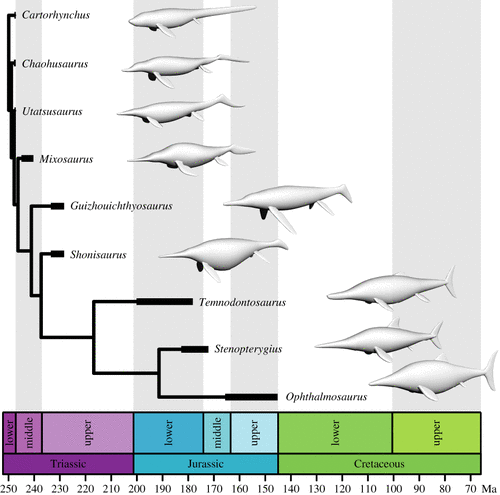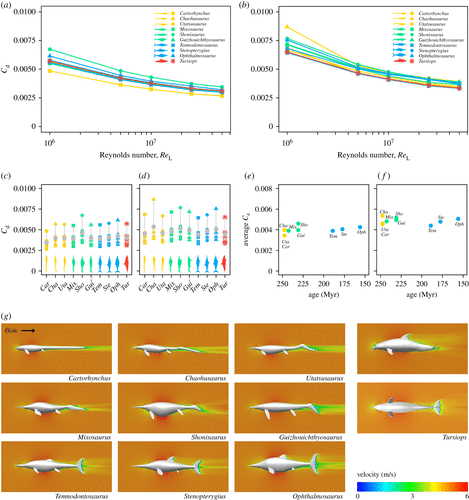@WFS,World Fossil Society,Riffin T Sajeev,Russel T Sajeev
Using computer simulations and 3D models, palaeontologists from the University of Bristol have uncovered more detail on how Mesozoic sea dragons swam.
The research, published today in the journal Proceedings of the Royal Society B, sheds new light on their energy demands while swimming, showing that even the first ichthyosaurs had body shapes well adapted to minimise resistance and maximise volume, in a similar way to modern dolphins.

Digital models of the ichthyosaurs analysed in this study shown in their phylogenetic context. Simplified phylogeny
Ichthyosaurs are an extinct group of sea-going reptiles that lived during the Mesozoic Era, around 248-93.9 million years ago.
During their evolution, they changed shape substantially, from having narrow, lizard-like bodies to more streamlined fish-shaped bodies.
It was assumed that the change in body shape made them more efficient swimmers, especially by reducing the drag of the body, in other words, the resistance to movement.

Drag coefficients of nine ichthyosaurs and a modern analogue, the bottlenose dolphin. (a,b) CFD-computed total drag coefficients of nine ichthyosaurs and a bottlenose dolphin without (a) and with (b) limbs at Reynolds numbers from 106 to 5 × 107. (c,d) Comparison of the drag coefficients and their mean values (in grey) between taxa, without (c) and with (d) limbs; two-sample t-tests between groups not significant (NS). (e,f) Mean values of the drag coefficient of ichthyosaurs plotted against the mean occurrence age for each taxon, without (e) and with (f) fins; no correlation detected, Kendall’s τ = −0.29, p = 0.28, NS (no limbs); Kendall’s τ = −0.22, p = 0.39, NS (with limbs). Ichthyosaurs from the ‘basal grade’ are highlighted in yellow, the ‘intermediate grade’ in green and the ‘fish-shaped ichthyosaurs’ in blue. The bottlenose dolphin Tursiops is highlighted in red. (g) Two-dimensional plots of flow velocity magnitude (Re = 5 × 106; inlet velocity of 5 m s−1).
If they could produce less resistance for a given body mass, they would have more power for swimming, or swimming would take less effort. Then they could swim longer distances or reach faster speeds.
Susana Gutarra, a PhD student in palaeobiology at the University of Bristol’s School of Earth Sciences, said: “To test whether fish-shaped bodies helped ichthyosaurs reduce the energy demands of swimming, we made 3D models of several different ichthyosaurs.
“We also created a model of a bottlenose dolphin, a living species which can be observed in the wild, so we could test if the method worked.”
Dr Colin Palmer, a hydrodynamics expert and a collaborator, added: “Susana used classic methods from ship design to test these ancient reptiles.
“The software builds a “virtual water tank” where we can control variables like the temperature, density and speed or water, and that allow us to measure all resulting forces.
“The model ichthyosaurs were put into this “tank,” and fluid flow conditions modelled, in the same way ship designers test different hull shapes to minimize drag and improve performance.”
Professor Mike Benton, also from Bristol’s School of Earth Sciences and a collaborator, said: “Much to our surprise, we found that the drastic changes to ichthyosaur body shape through millions of years did not really reduce drag very much.
“All of them had low-drag designs, and body shape must have changed from long and slender to dolphin-like for another reason. It seems that body size mattered as well.”
Susana Gutarra added: “The first ichthyosaurs were quite small, about the size of an otter, and later ones reached sizes of 5-20 metres in length.
“When we measured flow over different body shapes at different sizes, we found that large bodies reduced the mass-specific energy demands of steady swimming.”
Dr Benjamin Moon, another collaborator from Bristol’s School of Earth Sciences, said: “There was a shift in swimming style during ichthyosaur evolution. The most primitive ichthyosaurs swam by body undulations and later on they acquired broad tails for swimming by beating their tails (more efficient for fast and sustained swimming).
However, we found that some very early ichthyosaurs, like Utatsusaurus, might have been well suited for endurance swimming thanks to their large size, in spite of swimming by body undulations. Our results provide a very interesting insight into the ecology of ichthyosaurs.”
Susana Gutarra concluded: “Swimming is a very complex phenomenon and there are some aspects of it that are particularly hard to test in fossil animals, like motion.
“In the future, we’ll probably see simulations of ichthyosaurs moving through water.
“At the moment, simulating the ichthyosaurs in a static gliding position, enables us to focus our study on the morphology, minimizing our assumptions about their motion and also allow us to compare a relatively large sample of models.”
![Comparison of the effects of body shape, swimming style and body size on the net energy cost of steady swimming in ichthyosaurs. (a,b) Relative net cost of steady swimming (COTnet) for ichthyosaurs of the same mass moving at the same speed. (a) Differences owing to morphology, not accounting for swimming style (propulsive efficiency, η = 1). (b) Differences owing to body shape and swimming style, incorporating propulsive efficiency estimates from living aquatic vertebrates; η = 0.48 for anguilliform swimmers [31] and η = 0.81 for carangiform swimmers [28,29]. (c,d) Relative differences in the net cost of swimming owing to body shape and size (length for each taxon is the mean of multiple specimens), moving at the same speed of 1 m s−1, when swimming efficiency is not accounted for (η = 1) (c), or (d) after incorporating the propulsive efficiency as in (b). (e) Mean COTnet of ichthyosaurs at life-size scale calculated as in (d), plotted against the mean occurrence age for each taxon. Colour coding for (a–e) corresponds to the one used in figures 2 and 3.](http://www.worldfossilsociety.org/wp-content/uploads/2019/03/190220161034-ancient-finds-exlarge-169-2.gif)
Comparison of the effects of body shape, swimming style and body size on the net energy cost of steady swimming in ichthyosaurs. (a,b) Relative net cost of steady swimming (COTnet) for ichthyosaurs of the same mass moving at the same speed. (a) Differences owing to morphology, not accounting for swimming style (propulsive efficiency, η = 1). (b) Differences owing to body shape and swimming style, incorporating propulsive efficiency estimates from living aquatic vertebrates; η = 0.48 for anguilliform swimmers [31] and η = 0.81 for carangiform swimmers [28,29]. (c,d) Relative differences in the net cost of swimming owing to body shape and size (length for each taxon is the mean of multiple specimens), moving at the same speed of 1 m s−1, when swimming efficiency is not accounted for (η = 1) (c), or (d) after incorporating the propulsive efficiency as in (b). (e) Mean COTnet of ichthyosaurs at life-size scale calculated as in (d), plotted against the mean occurrence age for each taxon. Colour coding for (a–e) corresponds to the one used in figures 2 and 3.
Journal Reference:Susana Gutarra, Benjamin C. Moon, Imran A. Rahman, Colin Palmer, Stephan Lautenschlager, Alison J. Brimacombe, Michael J. Benton. Effects of body plan evolution on the hydrodynamic drag and energy requirements of swimming in ichthyosaurs. Proceedings of the Royal Society B: Biological Sciences, 2019; 286 (1898): 20182786 DOI: 10.1098/rspb.2018.2786



 March 8th, 2019
March 8th, 2019  Riffin
Riffin  Posted in
Posted in  Tags:
Tags: 